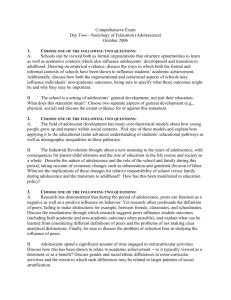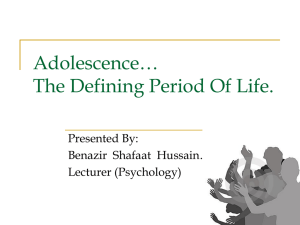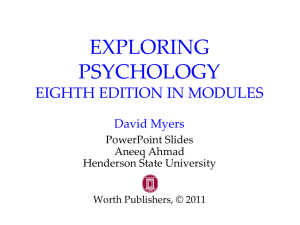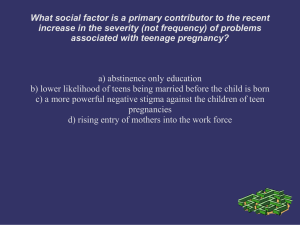Notes on Adolescence (Textbook) by Santrock
advertisement
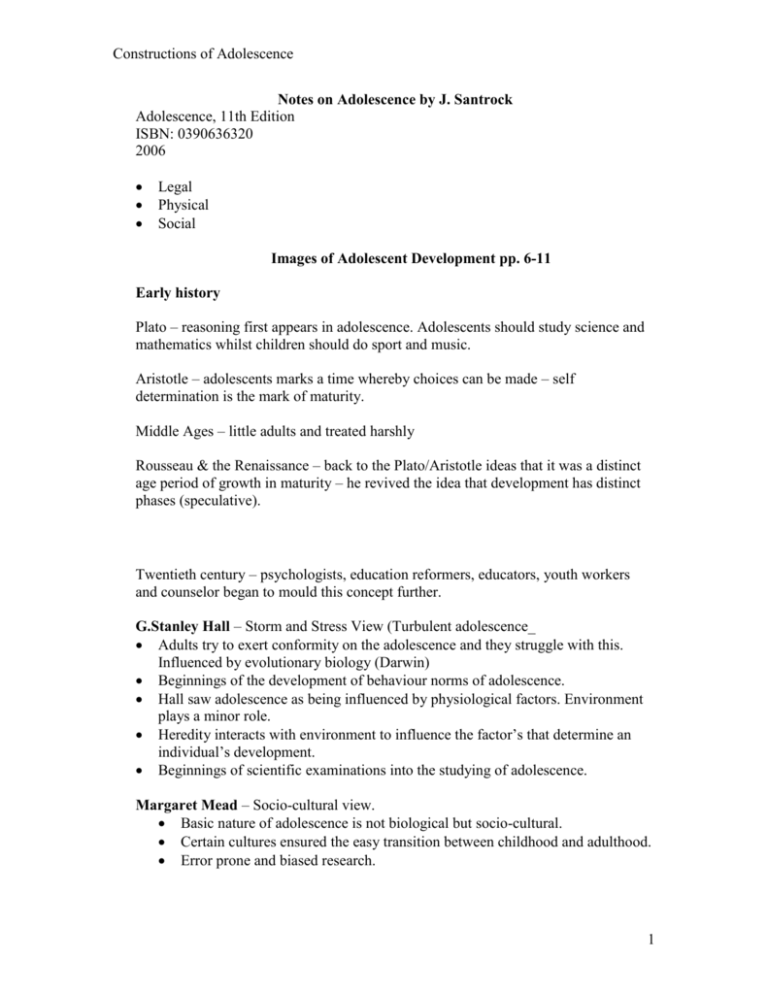
Constructions of Adolescence Notes on Adolescence by J. Santrock Adolescence, 11th Edition ISBN: 0390636320 2006 Legal Physical Social Images of Adolescent Development pp. 6-11 Early history Plato – reasoning first appears in adolescence. Adolescents should study science and mathematics whilst children should do sport and music. Aristotle – adolescents marks a time whereby choices can be made – self determination is the mark of maturity. Middle Ages – little adults and treated harshly Rousseau & the Renaissance – back to the Plato/Aristotle ideas that it was a distinct age period of growth in maturity – he revived the idea that development has distinct phases (speculative). Twentieth century – psychologists, education reformers, educators, youth workers and counselor began to mould this concept further. G.Stanley Hall – Storm and Stress View (Turbulent adolescence_ Adults try to exert conformity on the adolescence and they struggle with this. Influenced by evolutionary biology (Darwin) Beginnings of the development of behaviour norms of adolescence. Hall saw adolescence as being influenced by physiological factors. Environment plays a minor role. Heredity interacts with environment to influence the factor’s that determine an individual’s development. Beginnings of scientific examinations into the studying of adolescence. Margaret Mead – Socio-cultural view. Basic nature of adolescence is not biological but socio-cultural. Certain cultures ensured the easy transition between childhood and adulthood. Error prone and biased research. 1 Constructions of Adolescence Interventionist View – Sociohistorical condtions Legislation carried out to ensure the dependency of youth to adults Legislation about compulsory schooling – (as potential economic contributors OR as being given education – intellectual skills transmitted from adults to adolescents) World War I – teenagers/young adults recruited and became subject to new pressures and new opportunities. Increased school attendance Decreased employment for adolescents Further changes in Twentieth Century 1920’s – more freedom and opportunities – adults modeled themselves on the young fashions (dance, music, fashion), increased alcohol consumptions, changes in attitudes towards sex and fashion. 1930’s & 1940’s – more difficult times. Hedonistic values devalued. Greater independence from war time experience but also the danger to their lives. 1950’s – legal identity established – specific laws directed to youth. Television influence becoming felt. Higher education becoming more important. Also notions of the ‘rebel’ teenager. 1960’s – protests against Vietnam War – more politically active, more sexually liberated (cohabitation) increased drug use, rebelling against authority figures more openly. 1970’s – increasing female presence affected the description and study of adolescence. Focused moved to girls and women and more studies about gender and racial issues. Also more focused on college education to get better qualifications to get better jobs. Stereotyping of adolescents Perceptions and Misconceptions REVIEW AND REFLECT 1. Early history of interest in adolescence began in the early 20th century. The Greeks, Plato and Aristotle had ideas about the manner in which adolescents should be educated and about the changes that occurred during this period of development. The middle ages were a period of stagnation in that children were viewed as ‘little adults’ and treated as such. The Renaissance and Rousseau’s ideas brought back the concept of adolescence and the very beginnings of developmental theory were voiced. The early 20th century saw educators, counselors, youth workers and other groups looking toward developing theories of development, developing ideas about behaviour norms. 2 Constructions of Adolescence 2. The characteristic qualities of adolescence differed according to different perspectives. One theorist, G. Stanley Hall considered Adolescence a period of tumultuous change – storm and stress. During this period the adolescence experienced great changes in emotion, physical and mental states and often felt out of control. The adult society try to impose certain normative behavioural expectations on them and adolescents struggle with this process. This results from a more evolutionary biological perspective. A socio-cultural perspective, as described by Margaret Mead (Anthropologist) focused upon cultural and cultural influences rather than biological factors during the process of development. The socio-historical viewpoint posits that certain historical political, economic and social changes in society affected the way the adolescents were viewed and treated, and the manner in which they behaved as a result of these contexts. 3. Stereotyping refers to a situation where common traits are assigned to a broad group of people. It is used to describe a group of people by using specific characteristics or modes of behaviour. Adolescents are often portrayed as being lazy, petulant and rebellious. The gap between the adult and the adolescent in terms of age and experience amplifies this effect as the generations see the world from different perspectives. 4. A more positive view of adolescence is needed so that communication with adolescents is made more positive and constructive. Also, it is a misnomer that most adolescents are unhappy, restless or unmotivated. Numerous studies seem to show that generally they have a positive outlook. 5. Personal Experience of stereotyping o As I used to dress like a gothic girl, I used to be labeled as difficult and irrational. o As a student I used to be in the unpopular group who were labeled uncool, geeky, intelligent, losers. Social Contexts The cultural, political, social, economic situation where development takes place. Issues that affect development – socioeconomic status, race, religion, gender, education. Generational Inequality – benefits provided to older adults and not younger generation (e.g. Medical care costs) Health and Well being – Fewer adolescents suffering from disease and malnutrition but increased numbers of adolescents being affected by HIV AIDS (unprotected sex) and drug use. 3 Constructions of Adolescence Gender Gender affects the level of education that can be accessed. Western countries & Japan (and phillipines) allow more equal access for females to access education. This is not the case in places such as South and Central America, Southeast Asia and Arab countries. Control over women in terms of marriage, sexual behaviour, education and so on is being weakened in many places however. Family Ideas about social conducts, familial loyalty and obligation vary according to different cultural, political and social contexts. In some situations adolescents live in extended families and are duty bound to their parents. They could also be in situations where they are less restrictions on them, and may be in single parent or step-parent family situations. School In general the number of adolescents attending school is increasing. However many countries do not provide adequate education to adolescents. This many be as a results of economic, physical, political or social factors. In South America there has been a decline in adolescents who have access to secondary or higher education. Peers Some communities give more weight to peer relationships than others. In some communities (such as street kids in Brazil) the peer relationships act as surrogate parenting relationships. In Arab countries there are often restrictions on these relationships, especially for girls. REVIEW AND REFLECT Experience with adolescents, either through social or professional interaction would allow me to see the different social, political, economic and cultural contexts to which they belong. Especially interesting would be adolescents who have first generation migrant parents or non-english/traditional parents where there is a significant divide between the home and the wider community. It would be interesting to see how adolescent development differs in this group. The Nature of Development Key Developmental Processes o Cognitive changes – thinking and intelligence o Socioemotional changes – changes in emotions, personality, relationships and social contexts (school, youth groups etc) o Biological changes - puberty Key Developmental Stages 4 Constructions of Adolescence Childhood o Prenatal – conception to birth o Infancy – birth to 18/24 months – extreme dependency, psychological activities begin here (language, symbolic thought, sensorimotor coordination, social learning, parent-child relationship) o Early childhood – end of infancy to 5/6 years of age. Learning to become more self-sufficient. School readiness (following instructions, identifying letters), hours spent in play and with peers. o Middle to late childhood – 5/6 to 10/11. Mastery of fundamental skills such as reading, writing, maths. Exposed to large world and associated culture. Selfcontrol increases and emphasis on achievement. o Adolescence – key task is preparation for adulthood. Varies with cultural and historical circumstances. Current beliefs look at different stages of development within the adolescence period – e.g. puberty and school events signifying entry into adolescence and full-time jobs (or study?) as a entry into adulthood. o Adulthood – Early / Middle / Late. Developmental Transitions Adolescence to Adulthood Increasingly young people are delaying their entry into adulthood – demands of the information society means more education. Emerging adulthood – time of experimentation and exploration – career, relationships. Identity etc. Markers of adulthood – job, self-responsibility, independent decision making, Factors determining well being Intellectual Assets Positive links between life skills, school academic success, organization skills, decision making skills and positive outcomes. Links to good mental health, completion of school, higher education, positive moral values, good parent-child relationships, avoidance of problem behaviours. Psychological Assets 5 Constructions of Adolescence Positive mental health, optimism, self-regulatory skills, motivation, and confidence in competence are related to indicators of well being in adolescence and emerging adulthood. (other factors might include moral development, values, spirituality, relationship with community Social Assets Connectedness, integration and feelings of belongingness. Indicators include mastery of wide range of skills, adult educational and occupational attainment, selfregulation skills, health, optimism. Social assets also given good indicators to manner of transitions to adult roles such as partners, workers, community members etc. Continuity – cumulative change – what seems like abrupt discontinous events are a result of learning (growth and practice) e.g. a child’s first word (practice of sounds) or puberty (biological changes occurring) Discontinuity – distinct changes/abrubt – passing through a series of stages in which change is Qualitatively rather than Quantitatively different. E.g. child moves from not being able to think abstractly to being able to do so. This is a qualitative discontinuous change in development. From not understanding to understanding. Moving from one state of cognition to another. Earlier and Later experience – different ideas about where the most impact occurs, in early childhood or in later developmental states. Different theorists have different ideas and this will depend on cultural and historical contexts (e.g. Freudian theory about child-parent relationships Nature vs Nuture – environmental (social, cultural, economic, historical etc) vs biological (genetic) factors 6
